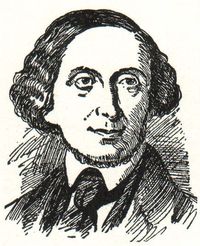mended. For general morphology, Thompson's Zoology and Parker and Haswelrs Text-book of Zoology are among the best. For comparative anatomy of invertebrates, see Lang's Text-book of Comparative Anatomy.
Anaxagoras (an-aks-ag'ō-ras), a Greek philosopher of Clazomenae, in Ionia, born about 500 B. C. At Athens he had for his pupils Pericles, Thucydides, Euripides and Socrates. He is spoken of as the first theist among philosophers, since he deemed reason the source of truth and matter the creation of an eternal Being, which he called νους (Intelligence). His atomic theory was thought at the time to be a slur on the gods, and for that he was banished, proceeding to Lampsacus, Mysia, where he taught until his death about 428 B. C.
Anchises (an-kī'sēz), in Greek legend, the son of Capys and father, by Aphrodite, of Æneas, the Trojan hero. At the burning of Troy, Æneas rescued him and bore him on his shoulders out of the city and made him the companion of his voyage to Italy. On the way thither, Anchises died in Sicily.
Ancho'vy, a small fish related to the herring, much used as a relish and for sauces, etc. They abound in the Mediterranean Sea and on the southern shores of Europe. Anchovies are also found on the coasts of the United States.
An'cient Mar'iner, The, a romantic poem written by Samuel T. Coleridge in 1797, first appeared in the famous volume of Lyrical Ballads, by Wordsworth and Coleridge which appeared in 1798. Wordsworth appears to have suggested some of the incidents of the story, for instance, the suggestion of a spectral persecution for a crime and the incident of the albatross. But the imagination and melodious beauty of the poem belong to Coleridge alone. The story is of an ancient mariner, who holds one of three wedding guests by the weird influence of his story and the glitter of his eye. He tells of a voyage to the South Seas, of heat and fog and mist, of the slaying of the bird that was thought to have caused it and of the punishment of the crew who perished and himself who lived in the clutches of the "Nightmare life-in-death." The rime concludes with the moral:
"He prayeth best who loveth best
All things both great and small;
For the dear God who loveth us,
He made and loveth all."
The ancient mariner had indeed broken the spell of evil about him, at least in part, by the love that gushed out of his breast towards the beauteous water-snakes that were playing about his stricken ship. Yet it is better to regard this poem as a perfect work of imagination than a too severe parable.
Anco'na, a city of Italy on the Adriatic Sea. It was one of the chief naval stations of the Romans. At that time its citizens made a famous purple dye, used in coloring the cloaks worn by kings and emperors. On its mole stands a triumphal arch in honor of the Emperor Trajan, which is said to be the finest marble arch in the world. Ancona has a fine harbor; it is to-day the chief seaport between Venice and Brindisi. Population 63,145. The province of the same name has an area of 748 square miles, and a population of 318,683.
Andalusia (ăn'dȧ-lōō'shŭ-ȧ), the most southern district of Spain. It is crossed by the Sierra Nevada Mountains and is watered by the Guadalquivir River. Here the Moors set up their famous kingdom and threatened to overrun Europe. The An-dalusian towns, Seville, Cordova, Jaen and Granada were the Moorish capitals. The present Andalusians are like the Moors in looks and manners, but are a mixed race, descended from Africans, Carthaginians, Romans, Goths and Vandals as well as Moors. The climate of Andalusia is delightful, and the country is rich in grains and fruit. It has also considerable mineral wealth. Its area is 34,000 square miles. Population of the eight provinces included in the area, 3,562,606.
An'dersen, Hans Christian, a Danish poet, novelist and writer of children's stories. He was born in Odense in 1805, the son of a shoemaker, who died when his son was nine years old.
After a scanty education and various attempts at work, his mother wished to make a tailor of him, but Hans, having a fair voice, preferred to go to Copenhagen for training. There he tried to get work at a theater, but was laughed at for his ignorance and awkwardness. A struggle of a few years, during which he wrote several tragedies, ended by his admission, through the influence of a benevolent man, into one of the government schools. This was the turning point in his life. He soon entered the Royal College of Copenhagen, and while there produced his first work in print, A Journey on Foot to Amak, a humorous work, which gained him much favor. Having received a gift of money from the king, he traveled through the south of Europe, describing its beautiful scenery in his great novel, The Improvisatore. After his return to Denmark, he was given an annuity by the government, until his death, which occurred Aug. 4, 1875. Among his works are Only a

